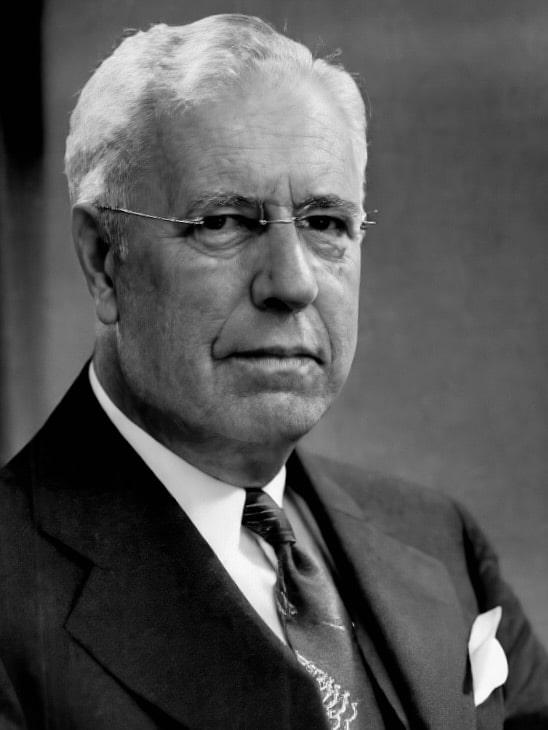Melvin S. Henderson

Melvin Starkey Henderson (1883–1954) was an American orthopedic surgeon
Henderson was a pioneering foundational figure in orthopaedics in the United States. As the first chief of orthopaedic surgery at the Mayo Clinic, he established one of the premier centres for musculoskeletal care in the early 20th century. Henderson’s legacy includes both clinical innovation and institutional leadership—he was a founder and first president of the American Board of Orthopaedic Surgery (ABOS) and a past president of the American Academy of Orthopaedic Surgeons (AAOS).
Henderson made significant contributions to the understanding of joint disorders, including early descriptions of synovial chondromatosis, later grouped under the eponym Reichel–Jones–Henderson syndrome. His detailed case studies and surgical observations on this and other joint pathologies helped distinguish mechanical and metaplastic joint disease before the era of advanced imaging. His 1921 presentation on Fractures of the Femur: End Results to the American Orthopaedic Association also underscored his commitment to outcome-based surgical reporting, then a rarity in orthopaedic literature.
He maintained a deep connection to the teachings of Sir Robert Jones (1857-1933) and Harold Stiles, having studied under them in the UK in 1911. Their influence is evident in his surgical philosophy, which blended technical skill with rehabilitation and long-term follow-up. Henderson also played a pivotal role in evaluating Sister Elizabeth Kenny’s unconventional treatment methods for poliomyelitis, advocating an open scientific appraisal when many contemporaries dismissed her outright.
Adept in clinical care, pedagogy, and institution building, Henderson retired from active surgical practice in 1948 but remained a respected figure in American orthopaedics until his death in 1954. His name continues to appear in historical references to synovial osteochondromatosis and the development of structured orthopaedic certification in the United States
Biographical Timeline
- 1883 – Born February 18 in St. Paul, Minnesota, to Melvin Brooks Henderson (1860–1939) and Emilie “Emma” Grace Starkey (1860–1894).
- 1894 – Following his mother’s death, moved to Winnipeg, Manitoba, to live with his aunt Eliza Starkey and Edward Drewry.
- Early 1900s – Completed undergraduate and medical degrees at the University of Toronto, Canada.
- 1907 – Returned to St. Paul; interned at the City and County Hospital. Began working as a surgical assistant with William James Mayo (1861–1939) and Charles Horace Mayo (1865–1939) at the Mayo Clinic in Rochester, Minnesota.
- 1911 – Traveled to the UK to study under Sir Robert Jones (1857–1933) in Liverpool and Sir Harold Stiles (1863–1946) in Edinburgh.
- Post-1911 – Returned to the Mayo Clinic and established the orthopaedic surgery section, which he headed until retirement.
- 1912 – Married Mabel Lillian Christensen (1884–1959) on February 10 in Forest Lake, Minnesota.
- 1916 – Published early works on orthopaedic conditions including synovial disorders.
- 1921 – Presented landmark study “Fractures of the Femur: End Results” to the American Orthopaedic Association.
- 1934 – Co-founded and became first President of the American Board of Orthopaedic Surgery (ABOS), established June 5 in Rochester.
- 1936 – Served as 5th President of the American Academy of Orthopaedic Surgeons (AAOS).
- 1940 – Supported Sister Elizabeth Kenny’s controversial polio treatment method, referring her for further evaluation despite medical opposition.
- 1948 – Retired from active surgical practice at the Mayo Clinic.
- 1954 – Died June 17 in Rochester, Minnesota, from cardiac disease aged 71.
Medical Eponyms
Reichel–Jones–Henderson syndrome
Primary synovial osteochondromatosis, a rare, benign metaplastic disorder in which the synovial membrane of a joint produces cartilaginous nodules that may calcify and become loose bodies. First described in 1900 by Friedrich Paul Reichel (1858-1934), the condition was later expanded upon by American surgeons Henderson and Hugh Toland Jones (1892-1980).
Henderson’s contribution was pivotal in distinguishing this entity from more common causes of intra-articular loose bodies, such as trauma or degenerative joint disease. Through meticulous case studies and operative findings, he demonstrated the synovial origin of the nodules, characterized by their uniform shape, multiple occurrence, and lack of trauma history. His clinical presentations and publications in the 1920s helped solidify recognition of the condition as a distinct synovial pathology.
Henderson’s work also informed early surgical strategies, particularly synovectomy combined with removal of loose bodies, and laid groundwork for understanding recurrence rates and long-term outcomes. The syndrome continues to bear his name alongside Reichel and Jones, particularly in radiological and orthopaedic texts, though modern usage more often favours the descriptive term “primary synovial chondromatosis.”
Major Publications
- Henderson MS. Loose bodies in the knee-joint. American Journal of Orthopedic Surgery, 1916; 14: 265-280 [Reichel-Henderson syndrome]
- Henderson MS. Loose bodies in the elbow joint. JAMA 1918;71;(3):177-180 [Reichel-Henderson syndrome]
- Henderson MS. Fractures of the femur: end results. The Journal of bone and joint surgery. 1921; 3: 520–528
- Henderson MS. Fractures with Special Reference to the Hip, Ankle and Elbow. Ann Surg. 1931 May;93(5):968-83.
References
Biography
- Melvin Starkey Henderson 1883-1954. The Journal of Bone & Joint Surgery 1954; 36(5): 1087-1088
- Mostofi SB. Melvin Starkey HENDERSON. In: Who’s Who in Orthopedics. Springer, London 2005: 135
- Melvin Starkey Henderson. WorldCat
Eponymous terms
- Reichel P. Chondromatose der Kniegelenkskapsel. Archiv für klinische Chirurgie, 1900; 61: 717-724.
- Jones HT. Loose bodies formation in synovial osteochondromatosis, with special reference to the etiology and pathology. The Journal of Bone and Joint Surgery, Boston, 1924;6:407-458.
- Symposium. Certification and accreditation in orthopedic surgery. Clin Orthop Relat Res. 1990 Aug;(257):1-66.
- Henderson MS. Fractures of the femur. End results : Melvin S. Henderson MD (1883-1954): the 5th president of the AAOS 1936. Clin Orthop Relat Res. 2008 Jan;466(1):41-6.
Eponym
the person behind the name
BA MA (Oxon) MBChB (Edin) FACEM FFSEM. Emergency physician, Sir Charles Gairdner Hospital. Passion for rugby; medical history; medical education; and asynchronous learning #FOAMed evangelist. Co-founder and CTO of Life in the Fast lane | On Call: Principles and Protocol 4e| Eponyms | Books |
